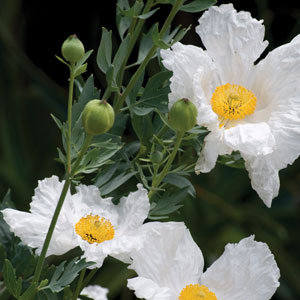Californian Tree Poppy Growing Guide

What is Californian Tree Poppy?
Californian Tree Poppy (Romneya coulteri) also known as Matilija Poppy or Fried Egg Plant is a vigorous, herbaceous perennial. It is part of the Papaeraceae family and is native to Southern California and Baja California. Californian Tree Poppy is a medium sized shrub that will grow in the hot, dry sandy spot in the garden where most other plants wont grow. They have silvery, grey green foliage that forms a spreading upright clump. In Summer they produce very large white papery flowers with a central boss of brilliant gold. The flowers look like a giant poached egg sitting on top of stiff branches. They do not like being re-located, but be prepared for them to spread easily by very active rhizomes.
Benefits of Growing Californian Tree Poppy
Californian Tree Poppy are incredibly tough and water wise. They are ideal for Mediterranean style gardens as well as fitting in perfectly to a cottage style, mixed border or other informal settings. Californian Tree Poppy can be used as a cut flower with their tall stems but the flowers are relatively short lived in the vase. The flowers attract bees and butterflies.
How to Grow Californian Tree Poppy
Climatic Zones
Cool, temperate, arid, semi arid.
Plant Size
Height: 2m, Width: 2-3m
When To Plant Californian Tree Poppy
Plant anytime.
Soil Preparation
They like moist but well drained soils but will grow in most soil types. Incorporate organic matter into the soil before planting.
How To Plant Californian Tree Poppy
Plant in full sun, 1.5-2m apart with the plant crown at soil level.
Californian Tree Poppy Plant Care
Water in well until established then keep moist while growing. They will be able to withstand long dry periods after they have established.
Fertilise with a complete fertiliser in Spring.
Light trim after flowering.
Powdery mildew and caterpillars can occasionally be a bother.







